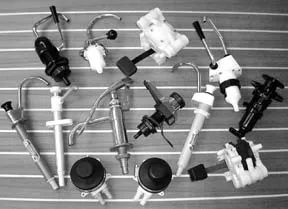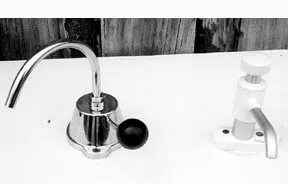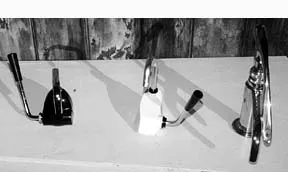
Time was, pressurized freshwater systems on mid- and small-size boats were a rarity. The galley had a single manual pump to draw water out of the tank and deliver it to the sink faucet. During the 1980s and 1990s new boats were delivered to customers with more and more standard equipment. In the plumbing department the list included head and cockpit showers, which necessitated an electric pump to pressurize the network of reinforced vinyl hose. A pressure tank is an important part of the system, too, because it reduces the amount of pump cycling as the pressure switch turns it on and off.
The well-equipped galley retains a manual (or pedal) pump, however, and the reasons are several. First, if power is lost, or the electric pump fails, water still can be obtained via the manual pump. Second, it’s impossible to leave a manual pump “on,” thereby eliminating wastage and encouraging conservation. (Non-sailing guests have a habit of leaving the pressure-water faucet on while brushing teeth and doing dishes, while you watch your precious supply of freshwater disappear down the drain.) Nowadays, in some countries, you might have even paid cold cash for that water.
For years, many offshore cruising and racing boats were equipped with an extra manual or pedal pump in the galley plumbed straight to a seacock, just for saltwater dishwashing and preliminary bathing.
If you’re willing to rough it just a bit, you’ll find that using a manual or pedal pump will also cut down on electric pump noise and battery drain. And if you can go without a pressure system altogether, you’ll free up stowage space, eliminate a lot of plumbing fittings and headaches, and generally find the boat quieter and a bit more relaxed. Unfortunately, many people who are used to pressurized water as standard equipment may find the idea of having to exert effort to draw water primitive and unacceptable. They should probably think of the pumps in this article as addends, not primary players.
The Models and the Test
Irish-made Whale pumps (Munster Simms Engineering Ltd.) and Fynspray pumps from New Zealand dominate the galley pump market. The only competitor we could find was Wilcox-Crittenden, the venerable maker of heads. The company has changed hands several times in recent years, with many products dropped and a few added, including a lever-type galley pump and a pedal-operated foot pump. Oh, and we did purchase the three-way Attwood faucet/pump, a clever concept but not much of a threat to the others’ manual models.
The hand-operated pumps can be divided into two categories, the first of which is the vertical design where the piston is actuated by a simple, straight up-and-down stroke. It’s an operation more easily performed if you stand above the pump; if the pump is at waist-to-chest height, it’s more of a strain on the arm muscles. The other category is the lever-actuated piston, in which a pivoting handle and an articulated connecting rod make for a back-and-forth stroke, which is often more comfortable when the pump is at waist-to-chest height.

Whale and Fynspray make several models of each type, Wilcox-Crittenden just the one lever type. The chart lists the various model numbers, features and prices.
In foot-operated pumps, Whale is the pioneer. It has long produced three basic types. The Whale Tiptoe model mounts flush in the sole and pops up when the tread-disk is rotated counterclockwise. The Gusher Galley Mk 3 is a lever-operated diaphragm pump that generally mounts in the vertical facing of the galley. The Baby Whale foot pump is covered by a rubber diaphragm and is actuated like the Tiptoe, that is, by stepping on it and releasing, stepping down and releasing.
Fynspray now has a foot pump to compete against the Baby, a near-identical copy. And Wilcox-Crittenden has a foot pump very similar to the whale Gusher Mk 3.
For evaluation, all of the pumps were mounted on a board and plumbed to a calibrated freshwater tank. Discharge hoses were led to an empty bucket. Each pump was operated several times at a reasonably rapid speed for 30 seconds and the output measured. The test was repeated several times for each pump and the figures averaged. The chart shows the results of this test.
During the test, observations were recorded regarding ease of operation.Afterward, each pump was examined for quality of materials, workmanship, design, and ability/ease of repair.
It must be noted that on opening the boxes and plastic packages, we were surprised at the dearth of informational material. The Fynspray pumps come with a small piece of folded paper with a parts diagram, parts numbers and maintenance tips, but there are no instructions on installing or operation. And only the Whale V-Pump Mk 6 came with any maintenance or repair advice. The Whale Gusher Mk 3 has some specifications and installation information printed on the box, but it is so small as to require a magnifying glass to read.
OK, these are hardly sophisticated machines, but it would be nice to at least be told what size hole saw is required for mounting, and what size hose should be purchased. Only the Whale V-Pump Mk 6 and Attwood 3-Way provided these two specs. How hard can it be?!
All pumps accept 1/2″ ID hose, except the Attwood 3-Way, as noted below.
Vertical Piston Hand Pumps
As already stated, the group of manual hand pumps can be divided into two sub-groups: those with vertical piston pumps, which we’ll describe first, and those with back-and-forth lever or rocker-type handles.

Like all brass Fynspray pumps, the Fynspray Vertical Brass WS-60 model, called the Caravan, is nicely made. The brazing is barely noticeable. It’s not highly polished, but not dull either. We give the finish a B or B+. It can be mounted vertically or at an angle. Periodic lubrication of the packing with petroleum jelly is recommended. Where most galley pumps have threaded bodies and locking nuts under the countertop, this model is simply secured by two screws through the mounting base plate into the top of the counter. This makes removal somewhat easier, since you don’t have to fiddle with a large under-counter nut often in cramped space behind the sink.
Though we have a slight preference for back-and-forth handles, we found the vertical action easy. And we liked the output: 3 to 3-1/2 quarts per 30 seconds operation.
We figured the Fynspray Vertical Plastic WS-67, mostly plastic but with metal plunger and spout, would perform nearly identically to its brass stablemate, but this was not the case. It pumped just 2-1/4 quarts, a full quart less than the WS-60.
The pump seems reasonably well made, but it was by far the noisiest of all pumps tested. It sounded like a motor with bad bearings. It has a threaded body and locking nut for countertops no more than about 1″ thick.At $22 less than the brass Fynspray Vertical, it might seem preferable, but we’d happily pay the difference for quieter operation, greater output, and the elegance of brass.
The Attwood 3-Way is a somewhat unusual pump in that it can function as a simple faucet (connected to a freshwater pump with built-in pressure switch), an electric faucet when connected to a pump without a pressure switch (because it has a switch built-in), and as a manual vertical hand pump. The idea here is to eliminate multiple fixtures. It comes with adapters for both 3/8″ and 1/4″ ID hose. The Attwood is made of black and chrome-effect plastic. The accompanying instruction sheet is by far the most complete of the nine pumps tested.
The short throw of this pump limits output; clearly it is intended for hook-up to a pressure system – boat or shore – and the manual is only an emergency back-up. Not a bad idea, but if all you’re looking for is a manual pump, look elsewhere.
The aluminum and plastic Whale V-Pump Mk 6 vertical pump can be connected to 1/2″ hose or to the Whale Water System 15, a rigid quick-connect family of pipe and fittings. It’s suitable for fresh or salt water. Mounting is with two screws through the base into the countertop. A clever feature is the ability to adjust the height of the pump body above the countertop by loosening a screw in the base.
A service kit sells for about $9 at discount. While most Whale and Fynspray pumps can be found in all major discount catalogs, only Defender Industries carries the V-Pump Mk 6 in its 2002 catalog.
The V-Pump Mk 6 operated smoothly in the tests, delivering about 2-1/4 quarts of water in 30 seconds, with 40 strokes.
The V-Pump Mk 6 is priced very close to the Fynspray Vertical Plastic WS-67, and their performance is close also. But the adjustable feature of the Whale and the noisiness of the Fynspray combine to make the Whale V-Pump Mk 6 the preferable vertical pump.
Lever and Rocker Hand Pumps
With its 9″ swiveling handle and 5/8″ diameter spout, the Fynspray Lever WS-62 is by far the largest and heaviest of the pumps tested. At 3 lbs. 10 oz., it’s not the one you want on a lightweight, high-performance boat. But on a heavy-displacement cruising boat, it’s strong, good looking and easy to operate. We had one for years, plumbed to salt water, and used it constantly for rinsing dishes, with nary a fault. It’s available in polished brass or chrome. No plastic here.
The WS-62 is a piston pump that solves the awkward vertical up-and-down motion by adding a pivoting handle that looks much like a manual well pump.
Owing to its size and long handle throw, one would think its output would dwarf all others, but surprisingly this was not the case. The Lever WS 62 produced just 3-1/4 quarts, less than both the Whale Flipper and Fynspray Rocker lever diaphragm pumps. No matter – if you want a classy manual pump at the galley, this is the one to buy.
Like the white Whale Flipper, the black (or optional white) Fynspray Rocker WS 63 is mostly plastic, but with chrome-plated handle and spout. Both also require large size cutouts in the countertop, though neither tells you the exact diameter. Of course, you can drill a smaller hole and insert a jigsaw blade to make the hole, but this results in a less than perfect circle, which even if hidden is objectionable.
The WS 63 can be used with fresh or salt water. A service kit sells for less than $7.
In the test, the Fynspray Rocker produced 4 quarts in 30 seconds, using 41 strokes. This is slightly better than the Whale Flipper.
One of the most popular galley pumps ever, the Whale Freshwater Flipper Mk 4 is made of aluminum, nylon, and synthetic rubber. The spout swivels, so there’s some flexibility in orienting it over a certain pot or portion of the sink. The service kit sells for about $20. To service, the pump must be removed from the countertop by unscrewing the large lock nut underneath. Eight screws on the bottom of the body must be removed to expose the guts.
In the test, the Flipper produced 3-1/2 quarts with 39 strokes in 30 seconds. This is roughly comparable to its chief competitor, the Fynspray Rocker, but costs $15 more.
The Wilcox-Crittenden 7128 is a nice-looking, chrome-plated brass pump made in Taiwan. The ball at the end of the handle is easy to grasp. It comes with a reducer so you can use either 1/2″ or 3/8″ ID hose. It also can be attached to pipe. The spout swivels. Mounting is with two screws through the base into the countertop.
In the test, the W-C 7128 was very consistent, putting out 2-1/4 quarts with 41 strokes. This is considerably less than the Whale Flipper and Fynspray Rocker WS-63, no doubt due to the smaller size of its chamber. But output isn’t everything, and this is still a nice pump.
Foot Pumps
For years, Whale stood alone in the manufacture of galley foot pumps. When we began collecting pumps for this evaluation, it appeared we’d be limited to three models from Whale. Then we recalled the old Sea Gal line of galley pumps from Wilcox-Crittenden; those aren’t made any longer, but in addition to the lever-type 7128 galley pump described above, W-C also now makes a galley foot pump. We were similarly surprised when a call to Imtra, US distributor for Fynspray, revealed that they, too, now offer a foot pump. The total number tested jumped to five.
Unlike all the other hand pumps, the small, freshwater-only Whale Baby Foot Pump is a diaphragm-type rather than a piston pump. It’s designed to be mounted on top of a horizontal surface, which makes it less than ideal for galley use. The height of the pump is 3″.
Output was low, just 1-1/2 quarts, but still more than the Attwood in hand pump mode, so it didn’t finish quite last.
The Whale Tiptoe is an exceedingly clever, all-plastic piston pump, designed to mount flush in the sole (floor) in front of the galley sink. Clearance underneath of 6-1/2″ is required. To get the pump ready for operation, you put your toes on the grated top of the plunger and turn it about an eighth of a turn counterclockwise to unlock. The pump pops up 1-1/4″. Then you just step down on it, release, step down again and so on. It’s suitable for fresh and saltwater.
Output was third lowest of the 13 pumps tested, just 2 quarts in 30 seconds, with a whopping 81 strokes. This, of course, is due to the small chamber volume and short stroke.
We like foot pumps and admire the Tiptoe’s slick, hideaway feature, but output is quite low for the effort required.
The most popular foot pump is the Whale Gusher Mk III, which has a variety of mounting options in its complicated plastic body casting, including horizontal and vertical surfaces. In most installations, the lever protrudes through a hole in a vertical surface, below the galley sink, so that you can wash dishes with your hands while maintaining a comfortable pumping motion with your foot. We used one of these diaphragm pumps for years while living aboard, and became so accustomed to the motion that when invited to dinner ashore, we’d stand at the kitchen sink with the right foot involuntarily pumping air, looking for all the world like a dog being scratched in its funny spot.
A brilliant feature of the Mk III is its rotating inlet and outlet hose barbs, which enable you to set them at the best angle for a clean hose lead.
Output exceeded all other pumps at 6-1/4 quarts in 30 seconds, using 67 strokes.
The Fynspray Mini WS-68 is nearly identical to Whale’s Baby Foot Pump. Examination of the molded bodies from the outside reveals virtually no difference. It wasn’t until we removed the rubber diaphragm that we saw slight differences in the ports, and in the rubber valves inside the intake and exhaust ports. Perhaps this explains the difference in performance. Where the Whale Baby delivered just 1-1/2 quarts, the Fynspray WS-68 averaged 2-3/4 quarts. We could feel the improvement during operation of the Fynspray.
Fynspray’s US distributor, Imtra, told us that these pumps are mostly used for hand washing in commercial applications, and that a suitable marine use is pumping out large ice chests.
If the surface mounting of this pump does the job for you, wherever that might be, we’d take the Fynspray over the Whale.
After being surprised at Fynspray’s near copy of the Whale Baby, we were ready for a similar comparison of the Wilcox-Crittenden 6500 with the Whale Gusher Mk 3. The 6500, made in Taiwan, copies the Whale design, with a complicated molding that offers both vertical and horizontal mounting, and pivoting intake and exhaust ports for easier alignment of hoses or pipes. But they are not identical. The W-C is about the same size as the Whale Gusher, though output was 2 full quarts less. Go figure.
Conclusion
Whether you have electric pressure water on board or not, a good manual galley pump is a smart buy. If on the ocean, you might plumb it to salt water to save fresh water, and if the pressure system goes down, you could replumb it to the freshwater tank until repairs are made (be sure to buy a pump suitable for both fresh and saltwater).
After testing, our choices were fairly easy to make. We find the lever (also, “rocker” or “flipper”) motion easier on the forearm than vertical piston pumps. Among lever hand pumps, we like the heavy and expensive Fynspray Lever WS-62. It’s a workhorse, and good-looking. If you want to retain the elegance of metal but spend less, the W-C 7128 works well, though output is less. Among the two plastic and metal lever types, the Fynspray Rocker WS-63 puts out more than the Whale Flipper – and costs less.
Among vertical piston pumps, we found the Fynspray Vertical Brass WS-60 pump fairly easy to use, and good-looking. But it’s $17 more than the Rocker.The Whale V-Pump Mk 6 at just $39 is a Best Buy.
Among foot pumps, our definite preference is for the Whale Gusher Mk 3. This pump has terrific output, is well-designed and made, and is a great alternative to hand pumps, freeing up the hands for easier clean-up.
In an ideal set-up, we’d use the Whale Gusher Mk 3 for freshwater and the big brass lever Fynspray WS-62 for salt water.
Also With This Article
Click here to view “Value Guide: Manual Galley Pumps.”
Contacts – Attwood Marine, 616/897-9241, www.attwoodmarine.com. Fynspray, 508/995-7000, www.imtra.com. Whale Water Systems, 978/531-0021, www.whalepumps.com. Wilcox-Crittenden, 860/447-1077, www.wilcoxcrittenden.com.































